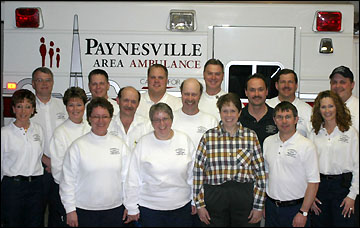Ambulance starts operating with paramedic
The change is possible because of a new state license that allows ambulance corps to run part-time as Basic Life Support (with EMTs) and part-time as Advanced Life Support (with paramedics). "The state will allow us to run as a paramedic when we have a paramedic on duty," said ambulance director Steve Stang.
 Currently, the 15-member crew has two trained paramedics: Chuck Schmidt and Clyde Swenson. Schmidt, who trained as a paramedic 12 years ago, was limited to work as an EMT for years until the license change. He works for the Paynesville Area Health Care System and takes ambulance call during most weekdays.
Currently, the 15-member crew has two trained paramedics: Chuck Schmidt and Clyde Swenson. Schmidt, who trained as a paramedic 12 years ago, was limited to work as an EMT for years until the license change. He works for the Paynesville Area Health Care System and takes ambulance call during most weekdays.
Swenson, who is relatively new to the Paynesville crew, is still learning the local protocols and could start working as a paramedic by this summer.
Members of the Paynesville Area Ambulance are: (front) Alice McColley, Margie Schutz, medical director Heidi Malling, M.D., and Mike Noonan; (middle) Bernie Stang, Darcy Alstead, paramedic Chuck Schmidt, Dave Schutz, director Steve Stang, and Tina Froelich; (back) Larry Bollman, Jeremy Nelson, Rich Holzer, Jamie Soine, Tom Fordyce, and paramedic Clyde Swenson.
Paramedics have some advantages over EMTs. One being that paramedics can handle patient transfers without having a nurse ride along, as required with EMTs.
This cost savings will accumulate, since nearly half of the runs of the Paynesville Area Ambulance are for patient transfers and most transfers occur during the day, when Schmidt is on duty.
But, more importantly, having a paramedic might save lives. So it fits with the Paynesville Area Health Care System's goal of "Caring for Life," said acute care administrator Bev Mueller. PAHCS operates the Paynesville Area Ambulance.
"The biggest advantage is (paramedics) get a higher level of care to people at the site, rather than waiting until the people get to the (hospital)," agreed Dr. Heidi Malling, the medical director for the ambulance corps for the past two years.
Paramedics can issue medicine and can use manual control of the defibrillator. Response time is especially important in trauma cases and heart attacks, two of the more popular calls for the local ambulance corps. In trauma cases, paramedics can start morphine before the patient gets to the hospital, for example, and for heart attacks manually controlling the defibrillator could restart the patient's heart.
Time is keenly important in heart attacks since, within 4-6 minutes of the brain lacking blood flow, permanent damage will start occurring, said Malling. Quicker responses maximize the chances for life and minimize the chances for damage, she added.
Malling established protocols for the paramedics, and EMTs, to use. And monitors ambulance runs and analyzes the care given. She will work with both the paramedics and EMTs to insure that the care given is appropriate.
Even the local EMTs are more than EMTs now, added Stang. All have taken extra training and can start IV lines for fluids (saline solutions) in the field, which is important since starting IV lines sooner is easier than waiting to start them at the hospital.
In many trauma cases, the body automatically restricts blood flow to the extremities (arms and legs) and focuses the flow for the core body with the vital organs. That means by the time a patient gets to the hospital, his or her arteries might have constricted, making starting an IV very difficult for the emergency doctors and nurses, said Malling.
The public might not notice any changes in the ambulance corps despite the change, agreed Malling, Mueller, and Stang. The only change that might be noticeable is that paramedics may stay at the scene longer, trying to stabilize patients before transporting them to the hospital.
But, already, the EMTs on the ambulance corps do more than "load and go," as they did years ago as first responders, noted Stang. Already they work at the scene, too, to start patient care before transporting them to the hospital.
Contact the author at editor@paynesvillepress.com • Return to News Menu
Home | Marketplace | Community